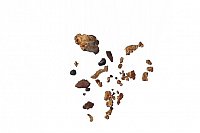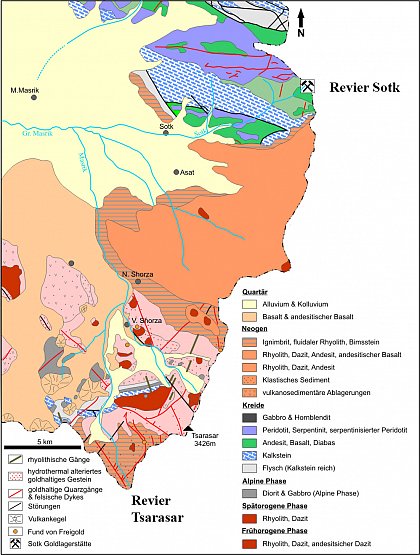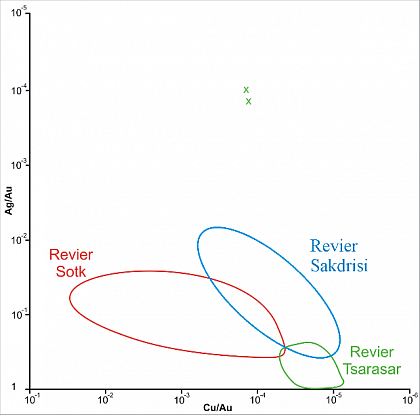Scientific Analyses of Natural and Artifact Gold
Based on the geochemical analysis of 73 analyzed gold nuggets using LA-ICP-MS at the Curt Engelhorn Center for Archaeometry in Mannheim, a clear differentiation between the placer gold of the Sotk territory and the newly-discovered Tsarasar territory (southwest of the Sotk gold deposit) can be determined within a closed natural environment (microregion) based on the two most important accompanying elements of gold (silver and copper). Basically, the placer gold from the Tsarasar territory as well as the river near the Bronze Age settlement of Norabak 1 shows a decreased copper content and an increased silver content. From the 31 analysed nuggets from the Tsarasar territory were found 29 electrons, whose silver content fluctuated between 29% and 46%. Among them were two cases of micronuggets, which were composed of almost pure gold.

Seifengoldprobe (Foto: D. Wolf, Halle)
The placer gold from the Sotk territory show a significantly lower silver content (4.4%-16%), but a substantially higher copper content (6 mg/kg-21 mg/kg) than the samples from Tsarasar. Analysis of areas of trace elements produced a more noticeable difference in the cobalt and nickel contents (under the detection level from those in the Tsarasar territory), as well as bismuth and antimony (higher content in the Sotk territory samples). Platinum group elements (PGE) were only identifiable in two of the 73 investigated gold nuggets. No differentiation is possible among the trace elements zinc, tin and tellurium.

Geologische Karte der Region Sotk und
der goldhöffigen Gebiete des Tsarasar Goldvorkommens
(Karte: D. Wolf, Halle)
A detailed comparison of the geochemical composition of the Sotk gold with the gold of the Sakdrisi deposit in southeastern Georgia begs to be acknowledged at this point, as the spatial distance between both deposits is only 200 km. The gold deposits in Sotk and Sakdrisi initially seem to only minimally differ in their geological composition. Also similar are the formations of the ore veins, the alterations of the wallrock, the types of veins, the mineral associations and the zoning of gold concentrations deep down. Numerous placers are likewise able to be found in the watercourses surrounding both reef gold deposits. The deposits only considerably differ from each other in size and in the gold concentrations lying close to the surface around the deposits. The deposits Sotk/Tsarasar are by far the largest gold deposits in the entire Caucasus, with an estimated deposit content of 124 tons of gold (Gugushvili 2010) and gold concentrations of up to 300 g/t in some areas (Elevatorski 1982, 141). An initial estimate for the content of Sakdrisi is set at a total of 23.5 tons (Gugushvili et al. 2002), with gold concentrations of up to 50 g/t (Hauptmann et al. 2010). The geochemical analyses of the placer gold from Sotk and Tsarasar were compared with the placer gold from Sakdrisi from Hauptmann et al. (2010). Numerous trace elements indicate that the gold from Sotk is geochemically significantly different from that of Sakdrisi.

Seifengoldanalyse zu den Revieren Sotk, Tsarasar (beides Armenien) und Sakdrisi (Georgien)
(Diagramm: D. Wolf, Halle)
While an already impressive amount of new data is available for the gold objects in Georgia (Hauptmann et al. 2010), there have been no geochemical analyses of gold objects manufactured in prehistory originating from Armenian contexts. Close cooperation with the Academy of Sciences allows first-time sampling and scientific study of gold objects from several different Bronze and Iron Age sites. The National Museums in Yerevan, Metsamor and Erebuni present excellent bases for targeted sampling of Bronze and Iron Age artifact gold – specifically, a first sampling of gold objects from the burials of Lori Berd, Metsamor, and Nerkin- and Verin Naver. The results of the respective current analyses will be presented promptly and continuously from this point onwards.

